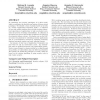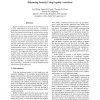1548 search results - page 77 / 310 » Estimating Software Vulnerabilities |
IEEEARES
2006
IEEE
15 years 5 months ago
2006
IEEE
-- Domain Name Systems (DNS) provide the mapping between easily-remembered host names and their IP addresses. Popular DNS implementations however contain vulnerabilities that are e...
NSPW
2006
ACM
15 years 5 months ago
2006
ACM
In considering new security paradigms, it is often worthwhile to anticipate the direction and nature of future attack paradigms. We identify a class of attacks based on the idea o...
ACSAC
2005
IEEE
15 years 4 months ago
2005
IEEE
Code injection vulnerabilities continue to prevail. Attacks of this kind such as stack buffer overflows and heap buffer overflows account for roughly half of the vulnerabilities...
ACSAC
2005
IEEE
15 years 4 months ago
2005
IEEE
We present e-NeXSh, a novel security approach that utilises kernel and LIBC support for efficiently defending systems against process-subversion attacks. Such attacks exploit vul...
WCRE
2005
IEEE
15 years 4 months ago
2005
IEEE
Buffer overflows have been the most common form of security vulnerability in the past decade. A number of techniques have been proposed to address such attacks. Some are limited t...




